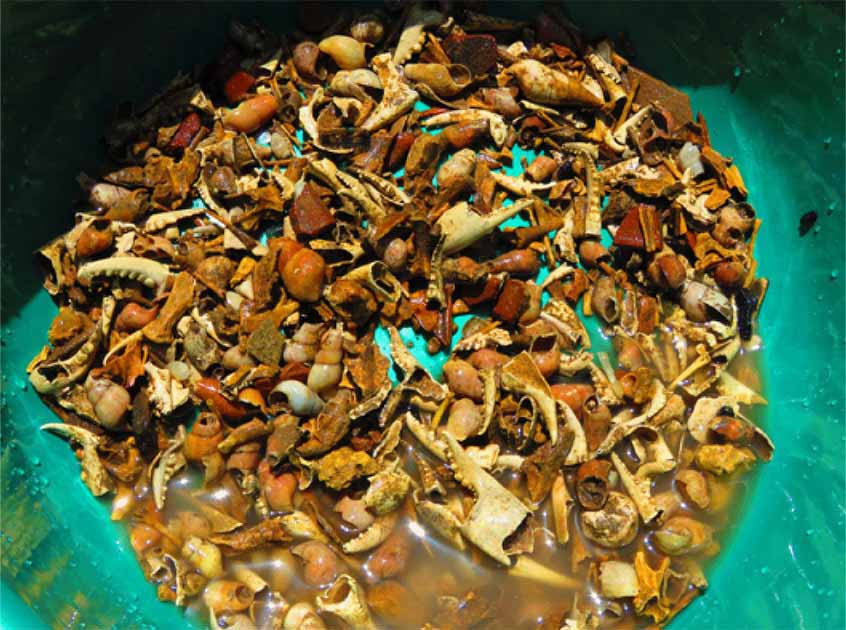Sieving For Micro-Insights into the Maya Rituals at Palenque Palace
Archaeologists in Mexico are enjoying fresh insights into the Maya people’s relationship with animals, having devised a new sieve to capture micro-remains.
The Maya city of Palenque (fortified place) is located in the foothills of the Chiapas altiplano of modern Mexico. This famous ancient settlement was active from the Classic period (200 - 900 AD) and it became the capital city for northern Chiapas and southern Tabasco, which thrived between c. 600 and 750 AD. From this important center of trade, the kings of Palenque controlled a vast area, and now, at the Palace of Palenque, scientists are celebrating new found micro-archaeology.
Since 2018 the Architectural Conservation Project of the Palenque National Institute of Anthropology and History (INAH), and the Decorative Finishes of the Palace, has used sieves to recover vast amounts of tiny bones and animal remains. Now, with a new method of filtering mud, the results of their research have yielded thousands of important zooarchaeological remains.
- Temples of Palenque Reveal Story of Lady Cormorant and Her Three Sons, The Triad Gods
- Unravelling the Mysteries of the Tomb of the Red Queen of Palenque

The deposits of houses B and E revealed the majority exploitation of fish, one of the least studied animal groups in Maya zooarchaeology. (Palenque Archaeological Project, INAH)
Celebrating With Animal Feasts
The Palenque Palace is the most extensive building in the entire city. When functional, it was the center of civic and religious activities to which political powers from far and wide would come. INAH's Palenque Archaeological Project has now detected hundreds of tiny animal remains by using a finer sieve than normal, which combines sifting and flotation. Project collaborator, Carlos Miguel Varela Scherrer, says the team has identified tiny fish premaxillae and teeth which are only revealed ‘when the earth matrix has passed through water.’
So fine is the new filtering system that the archaeologists also captured ‘a dozen seeds, a kilo and a half of charcoal, very small beads made of shells and other materials, and even fragments of a millimeter of green stone that were part of the ritual deposits.’ Interpreted in context, the researchers concluded that the animal remains represent ‘a celebration banquet in the place.’
- The Secret Skull of Pakal the Great: An Academic Cover-Up?
- Maya Animation? Breathing Newfound Vitality into Ancient Maya Art

Carlos Miguel Varela Scherrer, excavating at the site. (Palenque Archaeological Project, INAH)
Micro-Sifting at Palenque Palace
It is believed that both the food and tiny objects were later deposited in cavities which were ritually burned and covered. Furthermore, it has been speculated that these deposits may have marked the beginning of architectural constructions.
Professor Varela Scherrer studies the relationships of the Maya with their environment, and she explained that after the excavation of the ritual deposits, ‘a process of sifting with water and floating on the riverbank was carried out.’
The experiment required two wooden supports with a 1/8 inch (0.32cm) opening mesh to be installed in the Otulúm stream. A 20-liter bucket was part-filled with excavated soil then placed in the stream. A wooden stick was swirled around in constant circular movements, and after this process was completed three times, the contents of the bucket were poured into homemade strainers. At the bottom, were the collections of coal and small animal bones.

Using a sieve that combines sifting and flotation with water, INAH's Palenque Archaeological Project has detected hundreds of these remains. (Palenque Archaeological Project, INAH)
Deep Diving The Palenque Palace
House B is located in the southwest corner of the Palenque Palace. Mud excavated from this area contained 17 animal species. INAH published a breakdown of this haul which comprised of ‘water mussel, the land snail, the apple snail, the freshwater crab, crappie, tenguayaca, white bass, quail, white turtle, nine-banded armadillo, domestic dog, cervid and white-tailed deer’.
House E contained a mixture of ‘flute, freshwater crab, white bass, crappie and castarica crappie, tenguayaca, pochitoque, white turtle, crocodile, quail, ocellated turkey, tuza and temazate.’ These specific animal remains informed the researchers that the elite inhabitants of Palenque exploited resources in nearby freshwater streams, swamps, lagoons and rivers, according to the INAH report.
Dr Scherrer concluded that if this new fine sieve methodology is applied across the Maya lowlands, over time, archaeologists would have a broad data set which would enable comparative analysis. This would in effect offer researchers at sites across Mexico an ever-greater insight into the relationship between the ancient Maya people with the animals that populated their shared environment.
Top image: Thousands of tiny remains discovered at the Palenque Palace archaeological site, Mexico. Source: Palenque Archaeological Project, INAH
By Ashley Cowie


















Comments
Fascinating. These remains are obviously some kind of deposit of rubbish, although that was not entirely clear in this article. As with any new technic, time will tell more. It's fascinating what people did and ate. Why and how too. The huge stone buildings are the obvious draw, but to fully understand, the microscopic details give a larger picture. For instance, the high amount of charcoal, or 'coal' in this deposit is very suspicious. Is it simply a rubbish pit where fire pit refuse was added, or was the refuse burned? Or both, and why. Is it because they intentionally mixed this to compost for soil amendments? It did take a lot of food to provide for the many people who were nessary to build this place. How much was brought here? And how much was grown here? Why did they disappear? Was it deseise, war, or paracites? These answers may be found with a microscopic veiw. I just hope investigation continues and discoveries are not hidden for political reasons. Free open non-adgenda science must always be pursued.